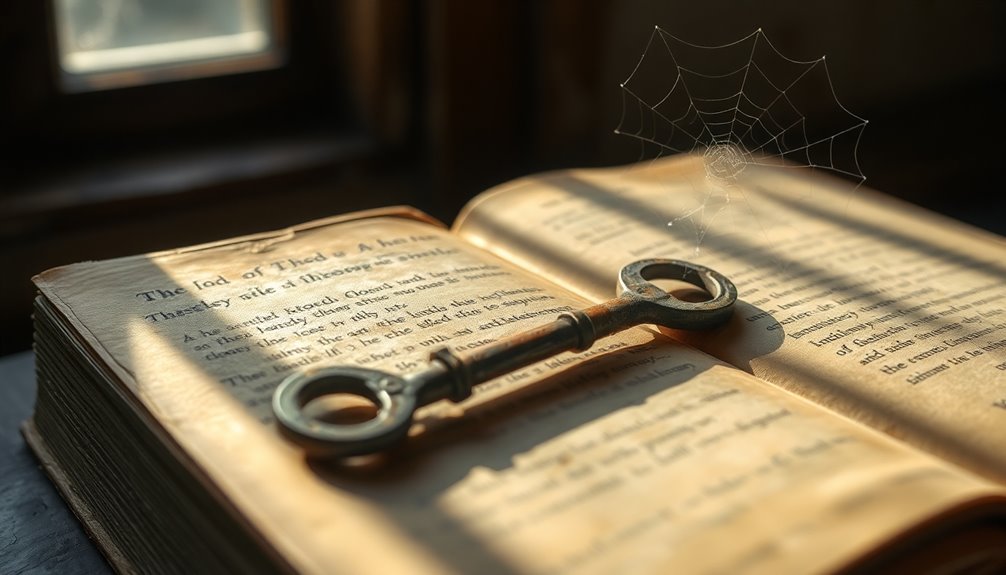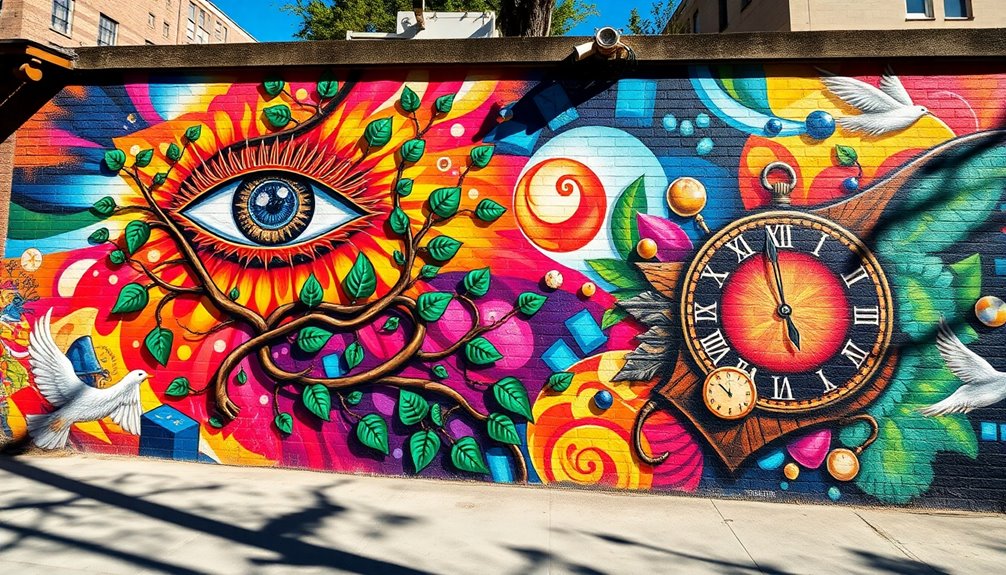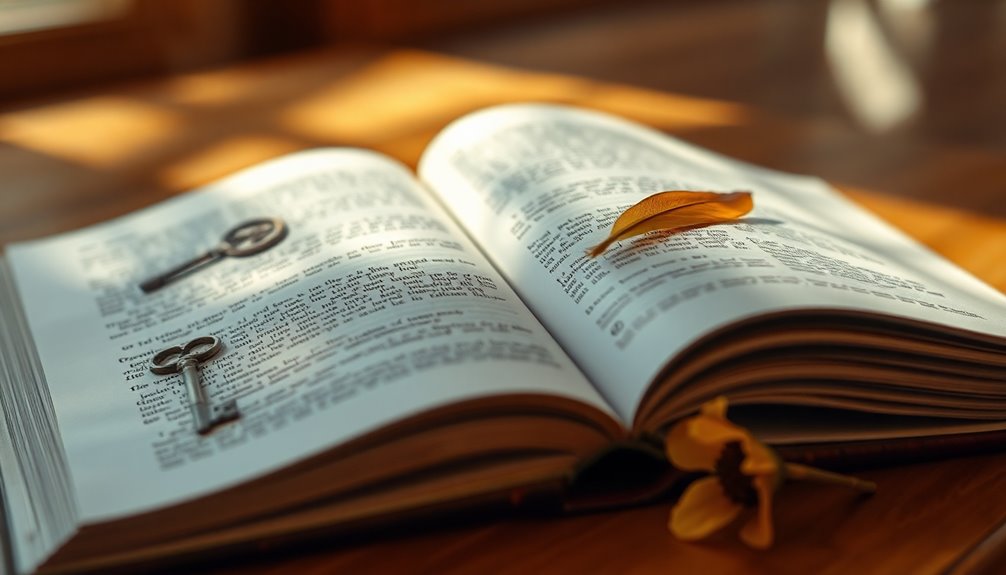Yes, symbolism is a key literary element that adds depth to stories! It helps you connect with emotions and ideas by using symbols—like characters, objects, or events—to represent bigger concepts. For instance, a dove might symbolize peace, while a broken mirror can represent lost hope. These symbols make the stories richer and more engaging because they invite you to think deeper about their meanings. Plus, your own experiences can change how you interpret them. So, every time you come across a symbol, get excited! It's a chance to uncover hidden layers in the tale you're enjoying, and there's so much more to explore!
Key Takeaways
- Yes, symbolism is a vital literary element that adds depth and complexity to narratives through representation of larger ideas.
- Strong symbols evoke emotions and convey abstract concepts, enhancing reader engagement and thematic richness.
- Symbolism can manifest as physical objects, characters, or events, each representing deeper meanings within the narrative.
- The interpretation of symbols is subjective, influenced by personal experiences and cultural contexts, allowing for diverse understandings.
- Analyzing symbolism fosters critical thinking and enhances the overall appreciation of literature, revealing hidden meanings within the text.
Understanding Symbolism

Exploring the depths of literature, you'll find that symbolism serves as a powerful device that goes beyond mere words. When authors use symbolism, they create objects, characters, or events that represent larger ideas. This approach adds depth and complexity to stories. For example, a simple rose might symbolize love, showing meaning beyond its literal appearance.
Strong symbols often share important traits with what they represent, allowing you to infer deeper meanings. Some symbols are clear and easy to spot, while others are more subtle, inviting you to think critically. This is where the fun begins!
As you immerse yourself in a story, consider how the symbols connect to the emotions and themes. The impact of symbolism isn't just about understanding; it's also about feeling. Effective symbols can evoke emotions, making you feel more connected to the narrative.
Remember, each reader might interpret symbols differently, based on their own experiences. So, as you read, keep an open mind. Let the symbols guide you through the story's layers, discovering the rich meanings hidden beneath the surface.
Additionally, symbolism can evolve with changing societal contexts, reflecting shifts in cultural significance and enhancing the reader's experience.
Embrace the adventure of exploring symbolism, and enjoy the journey it takes you on!
Characteristics of Symbolism

Symbolism in literature is marked by several key characteristics that enhance its effectiveness. When you read a story, you might notice how certain objects or events symbolize deeper meanings. These symbols represent something beyond their literal form, adding excitement to your reading experience!
Here are four characteristics of symbolism you should keep in mind:
- Emotional Impact: Strong symbols often evoke feelings, making the story more relatable and engaging.
- Representation: Symbols can represent abstract ideas, such as love or freedom, allowing you to connect with broader concepts.
- Significant Relationships: Effective symbols often share a close relationship with what they symbolize, enhancing the overall theme of the story.
- Variety of Forms: Symbols can come in many shapes and sizes, including characters, objects, or events, each adding emotional weight to the narrative.
Understanding these characteristics will help you appreciate how authors use symbolism to create rich, layered meanings. For instance, the Tiki Figures in Polynesian culture symbolize strength and protection, illustrating how cultural symbols can deepen narrative themes.
As you dive deeper into the text, you'll find yourself discovering new interpretations and connections, making reading a joyful adventure!
Types of Symbolism

Let's explore two exciting types of symbolism: physical object symbolism and character symbolism!
Physical objects, like a lovely flower, can represent big ideas such as beauty or innocence, making stories even richer.
On the other hand, characters can embody important traits, like Britomart from *The Faerie Queene*, who stands for chastity—showing how these symbols add depth to the tales we love!
Physical Object Symbolism
Utilizing tangible items to convey deeper meanings, physical object symbolism plays an essential role in enriching narratives. These symbols can represent abstract ideas, allowing you to connect with the story on a deeper level. They can symbolize anything, from love to struggle, and they often evoke emotional responses that make the narrative's depth even more engaging.
Here are some common examples of physical object symbolism:
- Flowers: A white lily might symbolize purity, while a red rose often represents love and passion.
- Crown: This item can symbolize power in one culture but may signify oppression in another.
- Worn-out shoes: These can reflect a character's struggles and their journey through life.
- Books: They often symbolize knowledge, wisdom, or even escape.
When you recognize these physical object symbols, you reveal layers of meaning in the story. By understanding how these items relate to the themes, you enhance your reading experience.
Character Symbolism
Through the lens of character symbolism, authors breathe life into their narratives by embodying virtues, vices, or ideologies within their characters. This literary device helps you see deeper meanings in stories. For example, in *The Faerie Queene*, Britomart represents chastity and the pursuit of moral goodness. Similarly, Jay Gatsby in *The Great Gatsby* symbolizes the American Dream and its disillusionment.
Character symbolism often shines through a character's growth or transformation. Take Scout Finch in *To Kill a Mockingbird*; she symbolizes innocence lost and moral awakening. These examples show how authors use characters to engage readers with rich themes and emotions.
Here's a simple table to help illustrate these ideas:
| Character | Symbolic Meaning |
|---|---|
| Britomart | Chastity and moral virtue |
| Jay Gatsby | The American Dream and disillusionment |
| Scout Finch | Innocence lost and moral awakening |
| Ebenezer Scrooge | Redemption and personal transformation |
| Hester Prynne | Sin, shame, and societal judgment |
Functions of Symbolism

While you mightn't always notice it, symbolism plays an essential role in literature by condensing complex ideas into tangible images. It's like a secret code, helping you uncover deeper meanings.
Here are some key functions of symbolism:
- Condenses Ideas: Symbolism simplifies complex thoughts, making them easier to understand.
- Enhances Themes: It links physical objects or actions to larger concepts, deepening the story.
- Fosters Interpretation: Through symbols, authors convey multiple layers of meaning, encouraging you to think critically.
- Elicits Emotions: Symbols can tug at your heartstrings, making the text more memorable and engaging.
When reading, look for these symbols. They often hold more meaning than the literal words on the page.
This subtlety allows authors to explore sensitive topics without being too direct. You might find yourself pondering big ideas or feeling strong emotions, all thanks to the power of symbolism.
Analyzing Symbolism in Literature

Unraveling the layers of symbolism in literature can transform your reading experience, revealing hidden meanings and enriching the narrative. When you explore the symbolism in writing, you'll discover that objects, characters, or events often represent larger ideas. For example, a rose might symbolize love, while a storm could represent conflict or change. These examples of symbolism help you see beyond the surface of the story.
The use of symbols can vary in difficulty. Some symbols are clear and easy to spot, while others are sneakier, waiting for you to analyze symbolism carefully. Don't worry if you don't get them right away! Your own experiences and insights play a big role in how you interpret these symbols.
Analyzing symbolism encourages you to think critically and engage with the literature more deeply. As you uncover layers of meaning, you'll notice how these symbols contribute to the overall theme and emotional impact of the work.
Symbolism in Other Mediums

Exploring symbolism in other mediums reveals how various forms of art communicate deeper meanings beyond their surface.
It's fascinating to see how symbolism shows up in film, architecture, music, and visual art. Each medium uses unique visual elements to evoke emotions and tell stories.
Here are some examples of symbolism across different art forms:
- In film, the "Rosebud" sled in *Citizen Kane* symbolizes lost innocence.
- Architecture like the Church of the Light in Japan uses a cross-shaped cutout to symbolize faith.
- Historical events, such as the Berlin Wall, symbolize division during the Cold War.
- Music often carries emotional weight, with lyrics and melodies reflecting cultural narratives.
When you think about it, the author might choose to use these symbols to connect with the audience on a deeper level.
Whether it's through a powerful melody or a striking visual element, symbolism allows creators to share meaningful ideas.
Common Symbols and Meanings

Let's explore some common symbols you might see in stories and what they mean!
For instance, red roses often stand for love, while rainbows bring thoughts of hope and new beginnings.
You'll also find symbols like doves, which represent peace, and keys that open doors to new opportunities, making literature rich and exciting!
Universal Symbol Interpretations
Recognizing universal symbols can deepen your understanding of literature and art, as these symbols often carry meanings that resonate across cultures. These symbols serve as powerful tools in storytelling, enhancing the messages conveyed through symbolism.
Here are some widely recognized meanings for common universal symbols:
- Red Roses: These symbolize love and passion, making them a popular choice in stories about romance.
- Doves: Often associated with peace and tranquility, doves reinforce themes of harmony and hope in various works.
- Black and White: The color black frequently symbolizes death or mourning, while white is linked to purity and innocence, creating a strong contrast in narratives.
- Skulls: Representing mortality, skulls remind us of the inevitability of death and the fleeting nature of life.
Additionally, rainbows represent hope and promise, symbolizing the beauty that follows adversity.
Understanding these universal symbols helps you appreciate the depth of a literary element like symbolism. It's exciting to see how these symbols can connect with your feelings and experiences, making literature and art even more meaningful!
Cultural Symbol Variations
Symbols can carry vastly different meanings across cultures, making their interpretations rich and complex. For instance, take the color red. In the U.S., it often stands for love and passion, while in China, it's all about good fortune and joy. Isn't that fascinating?
Similarly, the dove is a well-known symbol of peace. Yet, in some cultures, it also represents love or the Holy Spirit. It shows how one symbol can wear many hats!
The snake is another example. You might think of it as dangerous, but in other places, it symbolizes fertility or healing, showcasing the complexity of symbolic interpretation.
Let's not forget the lotus flower! In many Eastern cultures, it's a symbol of purity and enlightenment, while in other areas, it simply represents beauty. This tells us how cultural symbols can change their meanings depending on where you are.
Distinguishing Symbolism From Metaphor

Understanding the distinction between symbolism and metaphor is crucial for anyone diving into literary analysis. Both concepts enrich our understanding of texts, but they serve different purposes. Here's how to distinguish between them:
- Symbolism involves using objects to represent bigger ideas. For instance, a dove symbolizes peace.
- Metaphor directly compares two things, like saying "time is a thief." This conveys that time steals moments from our lives.
- Symbols can have multiple meanings based on the context, while metaphors usually stick to one meaning within a specific scenario.
- Symbolism often invites you to explore the deeper meaning behind an element, while metaphor provides a more direct comparison.
Recognizing these differences enhances your literary analysis skills. It helps you uncover the layers of meaning woven into a text.
When you see a symbol, think about what broader concept it represents. When you encounter a metaphor, consider how the comparison deepens your understanding of the subject.
Both tools are essential for enriching your reading experience, leading you to discover the joy of literature and its many interpretations!
Importance of Symbolism in Writing

Symbolism plays an essential role in writing, enhancing both the emotional depth and thematic richness of a narrative. Writers use symbolism to create lasting impressions on readers, making stories memorable. For example, in *Macbeth*, Lady Macbeth's blood spot symbolizes her guilt and remorse, leaving readers feeling the weight of her actions.
Imagery through symbols helps to illustrate complex themes clearly. Think about smoke in Seamus Heaney's poetry—it represents obscurity and danger, showing how symbols can add layers of meaning.
Color symbolism also enriches literature. In *The Great Gatsby*, the color green stands for materialism and the allure of wealth, connecting key themes throughout the story.
Symbols can define character traits and deepen your understanding. Harry Potter's lightning bolt scar symbolizes his unique identity and ties to his past, allowing you to connect with him on a deeper level.
Furthermore, characters like Pearl in *The Scarlet Letter* embody themes of sin and redemption, showcasing how hidden meanings add narrative depth.
In short, the importance of symbolism in writing is immense, making stories more engaging and thought-provoking for you, the reader.
Frequently Asked Questions
Is Symbolism a Element?
Yes, symbolism is definitely an important element! It uses objects, characters, or events to represent bigger ideas. For example, a dove might symbolize peace.
When you read, spotting these symbols can make the story more exciting and meaningful. You'll find that understanding symbolism helps you connect with the characters and themes on a deeper level.
Is Symbolism a Figurative Language or a Literary Device?
Imagine you're on a treasure hunt, searching for hidden meanings in stories. You might wonder if symbolism is a type of figurative language or a literary device.
Well, it's actually a literary device! Symbolism uses objects, characters, or events to represent bigger ideas.
Unlike figurative language, which compares things directly, symbolism adds depth and richness to a story.
What Is Considered a Literary Element?
A literary element includes the main parts that make a story come alive!
You've got plot, which is the storyline, and characters, who are the people in the tale.
Setting tells you where and when it happens.
Themes are the big ideas, and there's also symbolism, which uses objects to represent deeper meanings.
All these elements work together, helping you understand and enjoy the story even more.
Isn't that exciting?
What Is an Example of a Symbolic Element?
Imagine a shimmering green light across a dark bay. In *The Great Gatsby*, that light symbolizes Gatsby's dreams, always just out of reach.
It's like looking at a star you can't touch! Similarly, in *To Kill a Mockingbird*, the mockingbird represents innocence, urging you to protect the gentle.
Each symbol carries a deeper meaning, inviting you to explore the story's heart. These elements make reading exciting, revealing hidden layers and emotions!
Conclusion
In the world of writing, symbolism is like a treasure map, guiding you to deeper meanings and hidden gems. It adds layers to stories, making them more exciting and memorable. By understanding how symbols work, you can immerse yourself in your favorite books and uncover what the author truly wants to say. So, keep your eyes open for those special symbols! They're not just pictures; they're keys to revealing the magic of literature. Happy reading!











